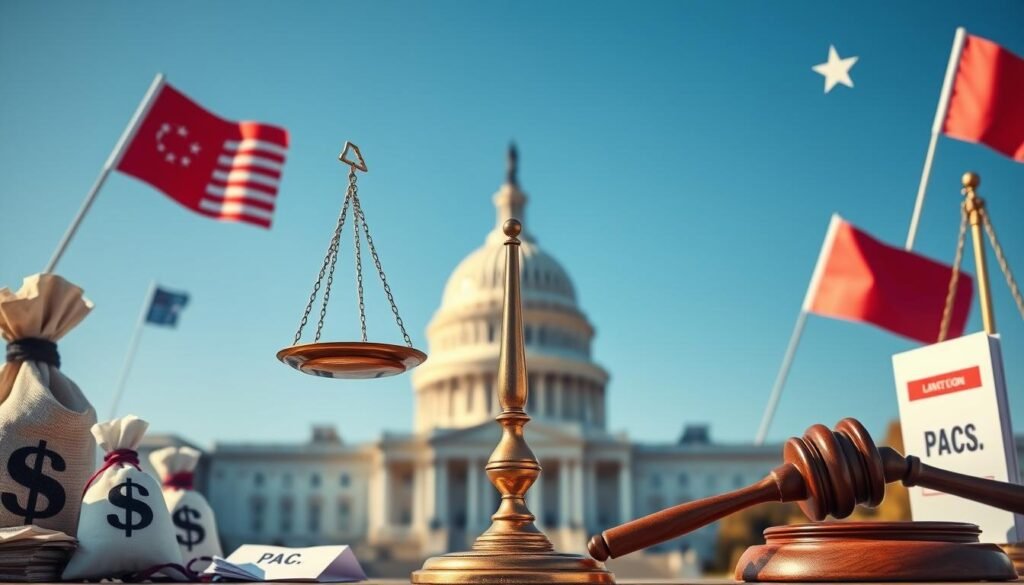Understanding the Legal Landscape of PACs in the US
By mid-September 2022, PACs had spent $5.89 billion in the current election cycle. Half of this money came from hybrid PACs, 32% from traditional PACs, and 18% from super PACs. The rules for PACs are complex, thanks to laws like the Federal Election Campaign Act (FECA) and the Bipartisan Campaign Reform Act (BCRA). These rules are key to understanding campaign finance.
Key Takeaways
- PACs have spent a total of $5.89 billion in the current election cycle.
- The Federal Election campaign Act (FECA) regulates campaign finance and eliminates financial abuses in political campaigns.
- PAC regulations, including the Bipartisan Campaign Reform Act (BCRA), impose restrictions on electioneering communications and contributions.
- The legal framework governing political action committees is complex and governed by various regulations.
- The Citizens United decision has had a significant impact on campaign finance laws, allowing for increased spending by PACs.
- PACs are subject to the legal framework governing political action committees, which includes regulations on contributions and spending.
- The legal landscape of PACs in the US is shaped by the interplay between PAC regulations, the Federal Election Campaign Act (FECA), and the Bipartisan Campaign Reform Act (BCRA).
The rules for PACs are vital in the world of campaign finance. Knowing these rules is key to understanding the complex world of campaign finance.
The Legal Framework Governing Political Action Committees
The rules for Political Action Committees (PACs) come from Campaign finance laws and Political committee compliance rules. These laws help keep campaign finance in check. The Federal Election Campaign Act (FECA) and the Bipartisan Campaign Reform Act are key.
PACs must sign up with the Federal Election Commission (FEC) within 10 days if they spend over $1,000 in a year. They can get up to $5,000 from one person each year. They can also give up to $5,000 to a candidate and $15,000 to a party committee.
Key Regulations
- PACs must register with the FEC for at least six months, get contributions from at least 51 people, and support at least five candidates.
- Leadership PACs help other candidates, not the person in charge. They can’t fund the leader’s campaign.
- Super PACs can take unlimited money from anyone, but can’t give to candidates or party committees directly.
Types of PACs Under US Law
The US law has different types of PACs, each with its own PAC regulations and PAC reporting requirements. You’ll find traditional PACs, super PACs, and hybrid PACs. Traditional PACs have spending and donation limits. Super PACs can spend as much as they want on independent ads. Hybrid PACs have two accounts, one for traditional and one for super PAC activities.
Some key characteristics of PACs include:
- Traditional PACs can contribute a maximum of $5,000 to a candidate committee per election.
- Super PACs can receive unlimited contributions from corporations, unions, and individuals.
- Hybrid PACs can engage in both traditional and super PAC activities, with separate accounts for each.
It’s important to know about the different PACs and their PAC regulations and PAC reporting requirements. This knowledge helps individuals and groups follow the rules and make smart choices in politics.
| Type of PAC | Contribution Limits | Reporting Requirements |
|---|---|---|
| Traditional PAC | $5,000 per election | Regular filings with the FEC |
| Super PAC | Unlimited | Regular filings with the FEC |
| Hybrid PAC | $5,000 per election (traditional account) | Regular filings with the FEC (both accounts) |
Formation Requirements and Registration Process
To start a Political Action Committee (PAC), you must follow federal and state laws. You need to register with the Federal Election Commission (FEC) and meet state rules. Under Federal election law, you must register within 10 days. This is done by filing FEC Form 1.
PACs also have to follow PAC fundraising restrictions. These rules limit how much money you can raise and spend. The FEC gives guidelines, and some states have extra rules. To register, you need to file a Statement of Organization (Form 1) with the FEC. This form asks for your PAC’s name, address, and treasurer.
Here are the main steps to register a PAC:
- Filing a Statement of Organization (Form 1) with the FEC
- Meeting state registration requirements
- Complying with PAC fundraising restrictions
- Maintaining accurate records and filing regular reports with the FEC
By meeting these requirements, a PAC can operate legally. It can also support its chosen candidates and causes effectively.
| PAC Registration Requirement | Description |
|---|---|
| Filing a Statement of Organization (Form 1) | Must be filed with the FEC within 10 days of PAC creation |
| Meeting state registration requirements | Vary by state, but may include additional filing requirements |
| Complying with PAC fundraising restrictions | Includes limits on contributions and expenditures |
Contribution Limits and Restrictions
It’s key to know about PAC regulations and Campaign finance laws. The Federal Election Commission (FEC) sets these rules. PACs must follow them to avoid trouble.
People and companies can give money to PACs, but there are limits. The amount you can give depends on the PAC type and who it supports. For instance, you can give up to $5,000 a year to a PAC. But, a candidate committee can only get up to $2,000 per election.
| Contribution Type | Limit |
|---|---|
| Individual to candidate committee | $3,300 per election |
| Individual to PAC (SSF and nonconnected) | $5,000 per year |
| Candidate committee to PAC | $5,000 per election |
Remember, these limits can change. PACs need to keep up with new Campaign finance laws and PAC regulations. Not following these rules can lead to fines and penalties.
Financial Reporting and Disclosure Requirements
Under Federal election law, PACs must file regular reports to show their financial activities. These reports are key to keeping campaign finance transparent. The Federal Election Commission (FEC) sets the rules for these reports. Not following them can lead to penalties.
PACs need to file quarterly and pre-election reports to show their spending and donations. They also have to file annual reports. The deadlines for these reports depend on the type of PAC and the election year. The FEC wants PACs to file reports online, and these are public documents.
- Quarterly reports are due on the 15th day of the month following the end of the quarter.
- Pre-election reports are due 12 days before the election.
- Annual reports are due on January 31st of each year.
It’s vital for PACs to meet these reporting deadlines to avoid fines. The FEC offers help and guidance to make sure PACs follow Federal election law.
| Type of Report | Deadline |
|---|---|
| Quarterly Report | 15th day of the month following the end of the quarter |
| Pre-Election Report | 12 days before the election |
| Annual Report | January 31st of each year |
Super PACs: Legal Framework and Operations
Super PACs are a big deal in US politics. They can spend as much as they want on ads and campaigns. This is thanks to the Citizens United decision. To work, Super PACs must follow PAC regulations and campaign finance laws. They have to tell who gives them money and report to the Federal Election Commission (FEC).
Here’s what Super PACs do:
- They can take money from anyone, like people and companies.
- They must register with the FEC within 10 days if they spend over $1,000.
- They have to say who gave more than $200 in a year.
Super PACs can choose to report every month or every quarter. Knowing these PAC regulations and campaign finance laws is key.
By following these rules, Super PACs can keep raising unlimited funds. This makes them a big player in US politics.
| Reporting Schedule | Deadline |
|---|---|
| Monthly | 20th of the following month |
| Quarterly | 15th of the month following the quarter |
Compliance and Oversight Mechanisms
Keeping the political process fair is key. The Federal Election Commission (FEC) makes sure PAC reporting requirements are followed. They do this by checking PACs regularly and taking action when needed.
Having good internal rules is important for following the law. This helps PACs stay out of trouble and be open about what they do.
- Regular review of financial reports
- Implementation of internal controls
- Training of staff on compliance procedures
By following these steps, PACs show they care about Political committee compliance. This helps keep the trust of everyone involved.
PAC Leadership and Administrative Structure
The leadership and structure of a PAC are key to following PAC regulations and Federal election law. The treasurer is in charge of the money. Other officials make sure the law is followed.
Some important parts of a PAC’s leadership and structure are:
- Following Federal election law and PAC regulations
- Reporting and being open about money
- Making decisions on who to give money to
A PAC’s leadership and structure help keep it honest and legal. Knowing about these helps people understand PACs and Federal election law better.
The table below shows the different types of PACs and what they are like:
| Type of PAC | Characteristics |
|---|---|
| Connected PAC | Raise money from a restricted class, can contribute up to $5,000 to candidates for federal office per election cycle |
| Nonconnected PAC | Can contribute $2,600 to one candidate per election, can raise money from a wider range of sources |
| Super PAC | Can raise and spend unlimited amounts of money, must disclose donors and expenditures |
Digital Campaign Finance Regulations
The digital world keeps changing, and campaign finance laws must keep up. The Federal Election Commission (FEC) is key in making sure digital campaign finance is fair and open. They handle PAC fundraising restrictions and online fundraising rules.
The FEC sets rules for online giving, like showing who gives money and how it’s spent. Social media ads must also follow rules about who paid for them. Cryptocurrency contributions are also watched closely, with the FEC giving advice on how they fit into campaign finance rules.
Online Fundraising Rules
- Contributions of $2,000 or more per year need to be shared
- Independent Expenditure Committees must spend $1,000 or more yearly to qualify
- Major Donor Committees give $10,000 or more yearly to California candidates or ballot measures
By following these rules, PACs can stay within campaign finance laws and avoid fines. The FEC offers help and advice to keep PACs transparent in their online fundraising.
Ethics and Transparency Requirements
PAC regulations demand strict ethics and transparency. Disclosure of donors and expenditures is key to keep public trust. Political committees must follow these rules to avoid penalties and keep elections fair.
Recently, many states have set up ethics commissions to watch over PACs. For instance, Vermont got a new ethics commission on January 1, 2018. The City of Pittsburgh also changed its Ethics Hearing Board. These boards have 5-9 members to stay impartial.
PACs must follow PAC regulations and be open about their work. This means they have to share who donates to them and what they spend money on. By doing this, PACs help keep elections honest and earn public trust.
Ethics and openness are vital in PAC work. So, PACs must focus on Political committee compliance and follow PAC regulations. This way, they keep public trust and ensure fair elections.
Recent Legal Developments and Court Decisions
The world of Federal election law and Campaign finance laws has seen big changes. The U.S. Supreme Court’s decision in Citizens United v. FEC is a key moment. It has greatly shaped today’s campaign finance scene.
Key developments include:
- More money from PACs and super PACs, with unlimited corporate spending adding billions to election influence.
- Lawmakers are pushing for the Stop Illegal Campaign Coordination Act and the DISCLOSE Act. These aim to improve enforcement and transparency in campaign finance.
- Circuit court rulings, like SpeechNow.org, have also played a big role in how Federal election law and Campaign finance laws are applied.
These changes show how Federal election law and Campaign finance laws are always evolving. There’s a constant push to find the right balance between free speech and the need for openness and fairness.
Conclusion
The rules for political action committees (PACs) in the U.S. keep changing. Their role in politics is often debated. The legal framework governing PACs has evolved a lot. Laws like the Federal Election Campaign Act (FECA) and the Bipartisan Campaign Reform Act (BCRA) have shaped their rules.
The number of PACs has skyrocketed. In 1974, there were about 600. By 1983, that number had jumped to over 3,500. This shows how important PACs have become in politics. The top 10 corporate PACs gave $2.4 million to candidates in 1982. Labor unions and trade groups also have PACs, making their voices heard more.
As PAC regulations change, it’s key to stay updated. People, groups, and candidates must follow the rules. Laws require detailed reports, limits on giving, and checks to keep things fair. Knowing these rules helps everyone play by the rules in politics.
FAQ
What is the legal framework governing Political Action Committees (PACs) in the US?
What are the different types of PACs under US law?
What are the requirements for forming and registering a PAC?
What are the contribution limits and restrictions for PACs?
What are the financial reporting and disclosure requirements for PACs?
How are super PACs regulated under the legal framework?
What are the compliance and oversight mechanisms for PACs?
What is the role of PAC leadership and administrative structure in ensuring compliance?
How do digital campaign finance regulations affect PACs?
What are the ethics and transparency requirements for PACs?
How have recent legal developments and court decisions impacted the legal landscape governing PACs?
Source Links
- What role do political action committees have in elections?
- United States campaign-finance laws | Political Donations, PACs & FEC | Britannica
- Political action committee
- PACs, Super PACs and More: Your Guide to Key Election Spending Vehicles
- Political Action Committee (PAC): Definition, Types, Super PACs
- Political Action Committee
- Registering as a Super PAC – FEC.gov
- Contribution limits for party committees – FEC.gov
- Contribution limits – FEC.gov
- Campaign Reports
- Campaign Finance Disclosure
- Political Action Committees (PACs)
- Microsoft Word – 1478 – 1499 – Online
- [Title]
- Open Government Foundations: Parliamentary Oversight – Open Government Partnership
- ASCLS Political Action Committee – ASCLS
- What is a Political Action Committee (PAC)?
- FEC Waves the White Flag on Yet Another Issue: Leadership PAC Abuse
- Introduction to campaign finance and elections – FEC.gov
- Campaign Rules
- Policy and other guidance – FEC.gov
- How Does the Citizens United Decision Still Affect Us in 2025?
- Citizens United v. Federal Election Commission: Annotated – JSTOR Daily
- Speechnow.org v. FEC – FEC.gov
- Political Action COmmittees: Their Impact on Elections and Government
- NRS: CHAPTER 294A – CAMPAIGN PRACTICES
























